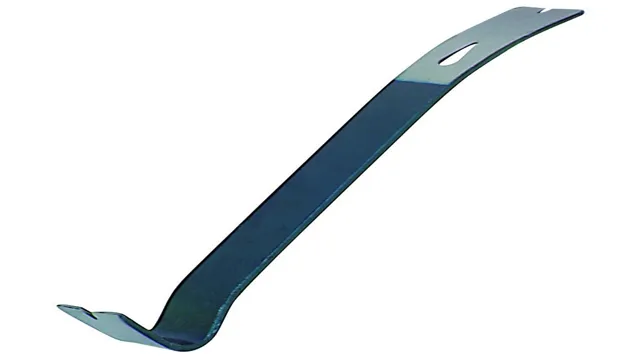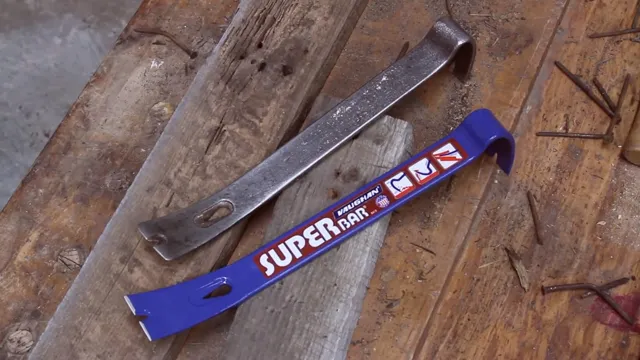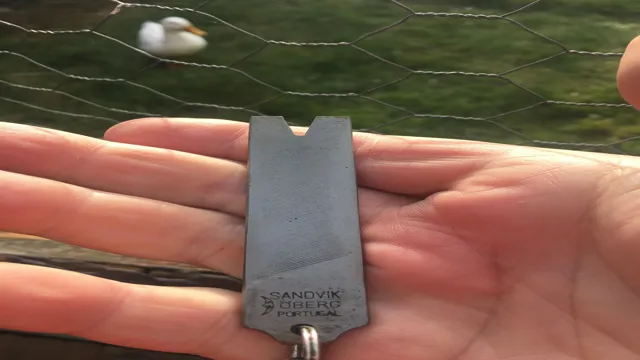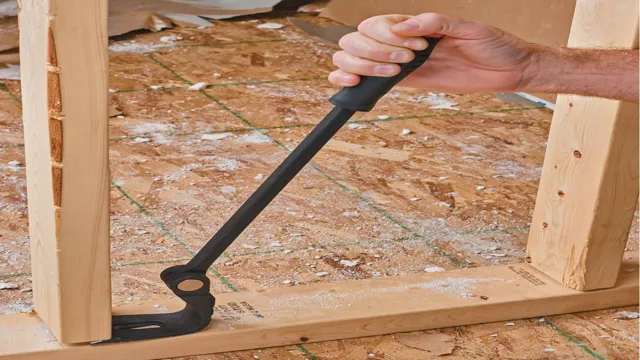What Does a Pry Bar Look Like? Discover the Key Features and Shapes of Pry Bars

Trying to figure out what a pry bar looks like? Well, wonder no more! This handy tool is a must-have in any DIYer’s toolbox – but what exactly is it, and how does it differ from other similarly-shaped tools? In essence, a pry bar is a long, slender piece of metal with a flat end and a curved end. The flat end is designed to be wedged underneath or between objects in order to pry them apart or lift them up, while the curved end can be used for leverage. Think of it like a miniature crowbar – except where a crowbar might be too large or cumbersome for certain jobs, a pry bar offers more precision and control.
In this post, we’ll dive deeper into the anatomy of a pry bar and explore some of its most common uses. So let’s get cracking!
Definition of a Pry Bar
A pry bar is a versatile tool that is used for a variety of purposes. It is essentially a long, flat metal bar that is often used to pry open objects or to remove nails. Pry bars come in different sizes, ranging from small ones that are a few inches long to larger ones that can be several feet long.
They can be made of different materials, such as steel or titanium, and may have different degrees of flexibility or resistance to bending. What does a pry bar look like? Well, imagine a strong, sturdy metal bar with a pointed end and a flattened end that tapers to a wedge shape. Some pry bars may have a curved end that makes it easier to manipulate and apply leverage.
These tools are commonly used in construction, automotive repair, and woodworking, among other industries, and are an essential part of any handyman’s toolkit. Whether you need to remove a door frame or pry open a crate, a pry bar is a tool that can make any job a little bit easier.
Description of a Pry Bar
A pry bar is a handy tool used for prying, lifting, and moving objects with ease. It is typically a long, flat bar with a curved end that can be wedged between two objects in order to apply force. This tool is often made of hardened steel and can come in a range of sizes, from small hand-held models to large crowbars.
The primary purpose of a pry bar is to create leverage, making it easier to remove nails, pull boards apart, or lift heavy objects. The curved end of a pry bar can also be used for chipping away at stubborn materials like concrete or tile, making it a versatile tool for any DIY or construction project. With its strong, durable construction, the pry bar is a must-have for any toolbox or workbench.

Different Types of Pry Bars
If you’re wondering what a pry bar looks like, there are actually several different types! The most common type is a flat pry bar, which has a long, flat metal bar with a curved end that can be used to lift and pry objects. Another type is a cat’s paw pry bar, which is shaped like a claw and is used for pulling nails out of wood. Then there’s the wrecking bar, which is a larger pry bar with a pointed end that’s designed for demolition work.
Some pry bars even have multiple functions, like the Stanley Fatmax 10-in-1 Multi-Tool, which includes a pry bar, nail puller, screwdriver, and more. No matter what type of pry bar you need, they all have one thing in common – they’re incredibly useful tools for tackling a wide variety of household and DIY projects.
Flat Pry Bars
Flat pry bars are versatile tools that come in handy for various tasks, from removing stubborn nails to prying open door frames. They are designed with a flat, chiseled blade on one end and a flattened claw on the other, making them ideal for leverage and breaking free objects that are stuck or screwed in. Some popular types of flat pry bars include hexagonal, gooseneck, and cat’s paw, each with unique features for specific needs.
The hexagonal is ideal for digging and carving, while the gooseneck allows for enhanced control and easy access to tight spaces. On the other hand, the cat’s paw is designed with a V-shaped notch that grips nails and staples, making it ideal for fasteners. Regardless of the type, flat pry bars are an essential tool that no DIY enthusiast should be without.
Roundhead Pry Bars
When it comes to demolition and renovation work, pry bars are an essential tool. Roundhead pry bars are one of the most commonly used types of pry bars. They come in different sizes and shapes to suit different purposes.
For instance, a short roundhead pry bar is great for working in tight spaces, while a longer one provides more leverage for heavy-duty tasks. The roundhead shape of the pry bar makes it easier to wedge into tight spots and pry open stubborn materials. One of the benefits of roundhead pry bars is that they are made from durable materials that can withstand tough jobs.
Many of these pry bars are constructed from heat-treated steel, which makes them less likely to bend or break under pressure. Moreover, their ergonomic handles are designed to offer greater comfort and reduce hand fatigue during extended use. Overall, a roundhead pry bar is an indispensable tool in any demolition or renovation project.
It can help you remove nails, pry open doors and windows, and even dismantle entire structures. With its sturdy construction and versatile design, it’s no wonder that roundhead pry bars are a favorite among professionals and DIY enthusiasts alike. So whether you’re a contractor or just someone looking to tackle a home improvement project, a roundhead pry bar is definitely a valuable addition to your toolbox.
Indexing Pry Bars
Pry bars are one of the essential tools for any handyman. These tools are perfect for removing nails, opening crates, or prying open anything. Pry bars come in different sizes and shapes, and each one has its specialty that makes it suitable for specific tasks.
The two most popular types of pry bars are flat bars and indexing pry bars. An indexing pry bar is a versatile tool that has a unique notch system. It can adjust in 14 different positions around the clock to provide the user with the perfect angle for maximum leverage.
On the other hand, flat bars are basic but efficient. They come in different lengths, and the tip is typically a wedge shape to facilitate entry. When deciding which pry bar to purchase, consider what type of work you will be doing and the size of the project.
Flat bars are great for basic tasks, while indexing pry bars are perfect for heavy-duty projects that need more power. Overall, both types will make your job much more manageable and efficient, so make sure to have at least one in your toolbox!
Materials Used in Pry Bars
So, what does a pry bar look like? Well, it’s a simple tool with a flat metal bar on one end and a curved claw on the other. Pry bars come in various sizes, from small ones that fit in your pocket to larger ones that require two hands to use. When it comes to the materials used in pry bars, they are typically made from high-strength steel or titanium.
The steel used in pry bars is usually treated with heat to increase its durability and strength. On the other hand, titanium pry bars are less common but have the advantage of being lightweight yet incredibly tough. Whether you’re using a pry bar to remove nails, pry open doors, or dig out rocks and roots, it’s important to choose one that is made from high-quality materials to ensure it won’t bend or break when you need it most.
Steel Pry Bars
Steel pry bars are reliable tools capable of exerting considerable force to dislodge stubborn objects or pry open tightly shut objects. As the name implies, steel is the primary material used in making steel pry bars since it is sturdy, durable, and malleable enough to bend and conform to different shapes required in making these tools. However, some steel pry bars come with a handle made from non-metallic materials, such as rubber or plastic, to offer a firm grip and prevent the tool from slipping from the user’s hand.
The steel material used in making pry bars has to be of high quality, durable and resistant to bending or breaking. This is why pry bars made from cheap or substandard steel should be avoided as they can easily snap or deform while under pressure, which could lead to unforeseen accidents during use. Therefore, it is important to invest in good quality steel pry bars that guarantee optimum performance and longevity.
Titanium Pry Bars
Pry Bars If you’re in the market for a pry bar, you may be wondering what kind of materials they’re typically made from. The most common materials used in pry bars are steel, carbon fiber, and titanium. Steel is the most affordable option and is often used in pry bars because it’s strong and durable.
However, steel can be heavy and may not be suitable for all applications. Carbon fiber is a newer material used in pry bars and is known for its lightweight and strength. However, carbon fiber pry bars can be expensive and may not be as durable as other materials.
Titanium is the most expensive option but is also the strongest and most durable material used in pry bars. It’s also lightweight, making it easy to handle for extended periods of time. Overall, the material you choose for your pry bar will depend on your specific needs and budget.
Conclusion
In short, a pry bar looks like the tool you never knew you needed until you need it most. With its sharp and rugged edges, it’s like the James Bond of toolboxes – always ready for action, regardless of the situation. Whether you need to leverage something open, or pry your way out of a tight spot, a pry bar is an indomitable force to be reckoned with.
So, the next time you’re wondering what a pry bar looks like, just imagine a superhero in tool form – because that’s exactly what it is.”
FAQs
What is a pry bar and what is it used for?
A pry bar is a tool made of steel with a flat or curved end used to apply leverage and lift objects. It can be used to remove nails, pull apart boards, or lift heavy objects.
What are the different types of pry bars?
There are several types of pry bars, including flat pry bars, curved pry bars, wrecking bars, crowbars, and pinch bars. Each type of bar is designed for a specific purpose and can vary in size and shape.
How do I choose the right pry bar for my project?
When selecting a pry bar, consider the size and weight of the object you need to lift or move. Also, consider the type of pry bar you need for the job. A flat bar may be best for removing nails, while a curved bar may be better for prying apart boards.
Is a pry bar dangerous to use?
Yes, a pry bar can be dangerous to use if not used correctly. Always wear protective gloves and eye-wear when using a pry bar. Use caution and never apply too much force, as the bar can snap and cause injury.
How do I properly use a pry bar?
To use a pry bar, position the flat or curved end under the object you want to lift or move. Apply pressure to the opposite end of the bar to lift the object. Be sure to keep the bar level and use caution to avoid injury.
Can a pry bar be used to break into a locked door?
While a pry bar can be used to break into a locked door, it is not recommended and may be illegal. Always use caution and follow the law when attempting to gain entry to a locked door.
How do I store a pry bar?
When not in use, store a pry bar in a safe and dry location to prevent rusting and damage. A sturdy tool box or wall mounted rack is a good option for storage.




